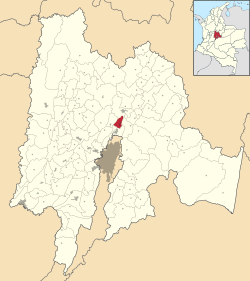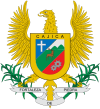Cajicá facts for kids
Quick facts for kids
Cajicá
|
|||
|---|---|---|---|
|
Municipality and town
|
|||

Church of Cajicá
|
|||
|
|||
| Nickname(s):
Fortaleza de Piedra
("The Stone Fortress") |
|||

Location of the town and municipality of Cajicá in the department of Cundinamarca
|
|||
| Country | Colombia | ||
| Department | Cundinamarca | ||
| Province | Central Savanna Province | ||
| Founded | 5 March 1598 | ||
| Area | |||
| • Municipality and town | 51.28 km2 (19.80 sq mi) | ||
| • Urban | 5.82 km2 (2.25 sq mi) | ||
| Elevation | 2,558 m (8,392 ft) | ||
| Population
(2018 census)
|
|||
| • Municipality and town | 82,244 | ||
| • Density | 1,603.82/km2 (4,153.9/sq mi) | ||
| • Urban | 54,111 | ||
| • Urban density | 9,297/km2 (24,080/sq mi) | ||
| Time zone | UTC-5 (Colombia standard time) | ||
| Website | Official website: http://www.cajica-cundinamarca.gov.co | ||
Cajicá is a town and municipality in Colombia. It is part of the Cundinamarca department. Cajicá is about 39 kilometers (24 miles) north of Bogotá, the capital city. It is located in the Central Savanna Province. Cajicá is the third most populated town in this area. Only Zipaquirá and Chía have more people.
Cajicá shares borders with several other towns. To the north is Zipaquirá. To the east is Sopó. Chía is to the south, and Tabio is to the west. The town is quite high up, at 2,558 meters (8,392 feet) above sea level. The weather is usually cool, with an average temperature of 14°C (57°F).
Contents
What Does the Name Cajicá Mean?
The name Cajicá comes from two old words. These words are ca and jica. Ca means "enclosure" and jica means "stone". So, Cajicá can mean "stone enclosure" or "stone fortress". Some people also think the name comes from a leader called cacique Cajic.
A Look at Cajicá's History
Early Times and the Stone Fortress
People believe that the area of Cajicá has been lived in for a very long time. Some historians suggest it was inhabited as far back as 12,460 BC.
There is a story about a stone wall or fortress in Cajicá. It was supposedly built in two stages. First, there was a wall made of wooden poles. Later, between about 1220 and 1400, a stone wall was built. Building with stone was rare for the Muisca people. This wall was said to be four meters (13 feet) high and 80 centimeters (31 inches) thick.
This Muisca fortress was thought to be in a very good spot. It was on the Bogotá savanna, a flat area near Bogotá. It was on a path between important regions. Travelers and soldiers might have used this path.
The Arrival of the Spanish
It is believed that Spanish explorers first met the Muisca people here. This meeting happened on March 23, 1537. It was the advance group of the conquistador army led by Gonzalo Jiménez de Quesada.
Founding of the Modern Town
In 1593, records show that 776 native people lived in Cajicá. The Spanish officially founded the town on March 5, 1598. On this day, Juan de Hoyo started building the first church. He was following orders from Miguel de Ibarra.
The first church and later churches were damaged by earthquakes. The church you see in Cajicá today was started much later. Its construction began in the late 1800s and finished in 1930.
How Cajicá Makes Money
Cajicá's economy relies a lot on its land. About 75% of the land in the municipality is used for farming. This means agriculture is a very important part of life here.
The town also earns money from tourism. Many wealthy people from Bogotá like to visit Cajicá. They come for country getaways. There are nice country houses and fancy restaurants. This makes Cajicá a popular place for weekend trips and holidays.
Gallery
See also
 In Spanish: Cajicá para niños
In Spanish: Cajicá para niños









